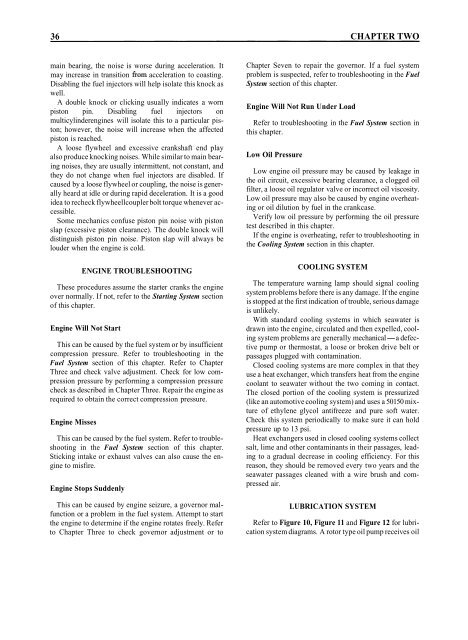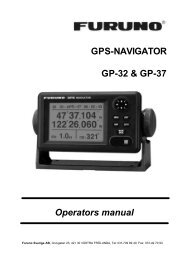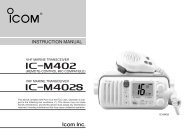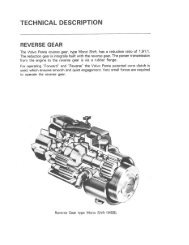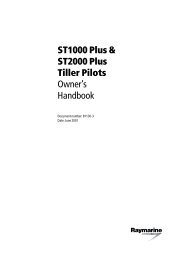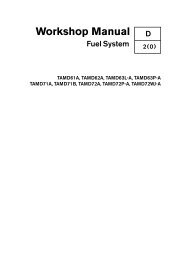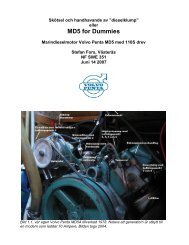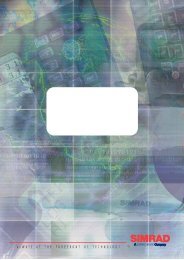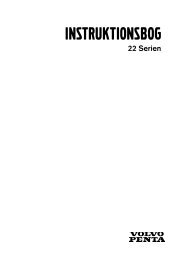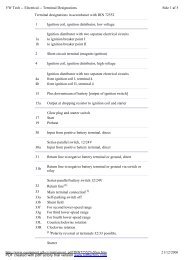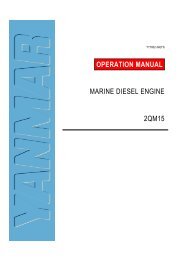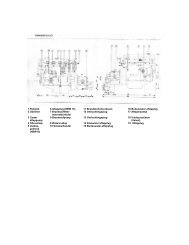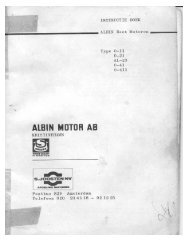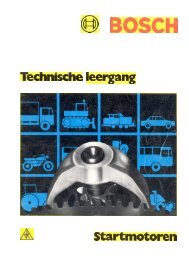You also want an ePaper? Increase the reach of your titles
YUMPU automatically turns print PDFs into web optimized ePapers that Google loves.
3 6 CHAPTER TWO<br />
main bearing, the noise is worse during acceleration. It<br />
may increase in transition from acceleration to coasting.<br />
Disabling the fuel injectors will help isolate this knock as<br />
well.<br />
A double knock or clicking usually indicates a worn<br />
piston pin. Disabling fuel injectors on<br />
multicylinderengines will isolate this to a particular piston;<br />
however, the noise will increase when the affected<br />
piston is reached.<br />
A loose flywheel and excessive crankshaft end play<br />
also produce knocking noises. While similar to main bearing<br />
noises, they are usually intermittent, not constant, and<br />
they do not change when fuel injectors are disabled. If<br />
caused by a loose flywheel or coupling, the noise is generally<br />
heard at idle or during rapid deceleration. It is a good<br />
idea to recheck flywheellcoupler bolt torque whenever accessible.<br />
Some mechanics confuse piston pin noise with piston<br />
slap (excessive piston clearance). The double knock will<br />
distinguish piston pin noise. Piston slap will always be<br />
louder when the engine is cold.<br />
ENGINE TROUBLESHOOTING<br />
These procedures assume the starter cranks the engine<br />
over normally. If not, refer to the Starting System section<br />
of this chapter.<br />
Engine Will Not Start<br />
This can be caused by the fuel system or by insufficient<br />
compression pressure. Refer to troubleshooting in the<br />
Fuel System section of this chapter. Refer to Chapter<br />
Three and check valve adjustment. Check for low compression<br />
pressure by performing a compression pressure<br />
check as described in Chapter Three. Repair the engine as<br />
required to obtain the correct compression pressure.<br />
Engine Misses<br />
This can be caused by the fuel system. Refer to troubleshooting<br />
in the Fuel System section of this chapter.<br />
Sticking intake or exhaust valves can also cause the engine<br />
to misfire.<br />
Engine Stops Suddenly<br />
This can be caused by engine seizure, a governor malfunction<br />
or a problem in the fuel system. Attempt to start<br />
the engine to determine if the engine rotates freely. Refer<br />
to Chapter Three to check governor adjustment or to<br />
Chapter Seven to repair the governor. If a fuel system<br />
problem is suspected, refer to troubleshooting in the Fuel<br />
System section of this chapter.<br />
Engine Will Not Run Under Load<br />
Refer to troubleshooting in the Fuel System section in<br />
this chapter.<br />
Low Oil Pressure<br />
Low engine oil pressure may be caused by leakage in<br />
the oil circuit, excessive bearing clearance, a clogged oil<br />
filter, a loose oil regulator valve or incorrect oil viscosity.<br />
Low oil pressure may also be caused by engine overheating<br />
or oil dilution by fuel in the crankcase.<br />
Verify low oil pressure by performing the oil pressure<br />
test described in this chapter.<br />
If the engine is overheating, refer to troubleshooting in<br />
the Cooling System section in this chapter.<br />
COOLING SYSTEM<br />
The temperature warning lamp should signal cooling<br />
system problems before there is any damage. If the engine<br />
is stopped at the first indication of trouble, serious damage<br />
is unlikely.<br />
With standard cooling systems in which seawater is<br />
drawn into the engine, circulated and then expelled, cooling<br />
system problems are generally mechanical-a defective<br />
pump or thermostat, a loose or broken drive belt or<br />
passages plugged with contamination.<br />
Closed cooling systems are more complex in that they<br />
use a heat exchanger, which transfers heat from the engine<br />
coolant to seawater without the two coming in contact.<br />
The closed portion of the cooling system is pressurized<br />
(like an automotive cooling system) and uses a 50150 mixture<br />
of ethylene glycol antifreeze and pure soft water.<br />
Check this system periodically to make sure it can hold<br />
pressure up to 13 psi.<br />
Heat exchangers used in closed cooling systems collect<br />
salt, lime and other contaminants in their passages, leading<br />
to a gradual decrease in cooling efficiency. For this<br />
reason, they should be removed every two years and the<br />
seawater passages cleaned with a wire brush and compressed<br />
air.<br />
LUBRICATION SYSTEM<br />
Refer to Figure 10, Figure 11 and Figure 12 for lubrication<br />
system diagrams. A rotor type oil pump receives oil


